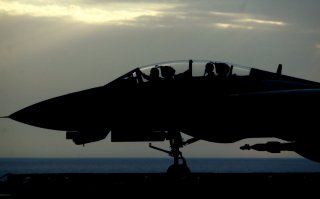F-14 Tomcat Vs F-14 Tomcat: 10 Crazy Shoot-Downs
History is filled with them. Read on.
2nd Lt. Owen Baggett was the co-pilot of an Army B-24 bomber sent to bomb Japanese facilities in Burma. Their plane shot nearly to pieces by Zero fighters, Baggett and four other crewmen bailed out. The Zero pilots made sport of the parachutists, machine-gunning and apparently killing two of them in mid-air.
Enraged, Baggett—still dangling from the silk canopy presumably thousands of feet in the air—drew his .45-caliber pistol and fired at a passing Zero. The Japanese plane stalled and crashed. Later, while a prisoner of the Japanese, Baggett learned that he had hit the Zero pilot in the head, killing him.
That March 1943 incident is just one of many bizarre shoot-downs that punctuate the century-long history of aerial warfare.
1948 & 1949: Royal Air Force Spitfires versus Israeli Spitfires versus Egyptian Spitfires
During skirmishes in the Middle East in 1948, the armed forces of Israel, Egypt and Great Britain all used pretty much the same models of Spitfire fighters, leading to fatal confusion.
British forces were pulling back from Palestine, leaving Egypt and the new state of Israel to fight it out over territory claimed by both Jews and Arabs. In May, waves of Egyptian Spitfires attacked the airfield at Ramat David, believing it to be held by Israel.
But in fact, British troops were still in charge of the base. The Egyptian planes unwittingly destroyed two Royal Air Force Spitfires and two transport planes and killed four men. With help from gunners on the ground, surviving British fighters destroyed five Egyptian Spitfires.
And after weeks of chaotic combat on three sides, in January 1949 two RAF Spitfires mistook two other RAF Spits as Israeli planes and shot them down, too.
September 1956 & June 1973: Grumman F11F & F-14 versus themselves
Thomas Attridge, Jr., a Grumman test pilot, was flying an F11F on trials off the U.S. East Coast, firing the jet’s 20-millimeter cannons into the water. In a steep supersonic dive, the Tiger actually outran its own cannon shells, which had been slowed by air resistance.
Rounds impacted the canopy, fuselage and engine, severely damaging the F11F. Attridge crash-landed the plane near Calverton, New York, gouging a 300-foot gash in the forest and breaking his leg. Based on the self-shootdown, the military began training supersonic jet pilots to turn away after firing guns.
But even missiles could turn on their users. Seventeen years after Attridge’s self-destruction, Grumman test pilot Pete Purvis fired a Sparrow air-to-air missile from an F-14 over California. Immediately after launch, the missile pitched up, striking the F-14 and puncturing a fuel tank. Purvis and backseater William Sherman safely ejected.
January 1968: CIA UH-1 versus North Vietnamese An-2s
A UH-1 helicopter flown by CIA pilot Ted Moore was carrying ammo to a U.S. Air Force radar installation on a mountain in Laos when four North Vietnamese An-2 biplanes attacked the site with guns and bombs. “It looked like World War I,” Moore recalled.
Moore positioned the copter over the slow-flying biplanes as crewman Glenn Woods fired an AK-47 assault rifle. In 20 minutes of slow-motion combat, Moore and Woods shot down two of the An-2s—a feat confirmed by a CIA ground team. Foiled in the air, the North Vietnamese later attacked the radar site on foot, destroying it.
Spring 1999: Serbian Mi-8 versus U.S. Air Force RQ-1
The Americans lost at least four RQ-1 Predator drones during the three-month air war against Serbia. The slow-flying robots were sometimes scrambled by NATO electronic jamming and crashed. Serbian defenses accounted for others.
One Serbian tactic was to send an Mi-8 helicopter to fly alongside a drone. The pilot would match speed and altitude with the robot and the copter’s door gunner would blast it with his machine gun. At least one Predator was reportedly destroyed this way.
David Axe serves as Defense Editor of the National Interest. He is the author of the graphic novels War Fix, War Is Boring and Machete Squad.

